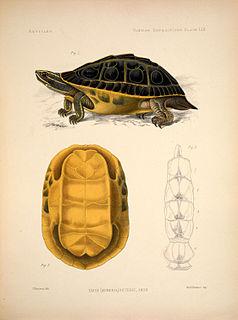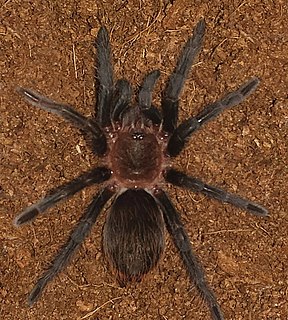
Avicularia is a genus of the family Theraphosidae containing various species of tarantulas. The genus is native to tropical Central and South America. Each species in the genus has very distinguishable pink foot pads.

The Indian eyed turtle is a species of turtle in the family Geoemydidae. The species is endemic to South Asia.

Cyriopagopus schmidti is a species of spider in the family Theraphosidae (tarantulas), found in China and Vietnam. It is one of a number of species known as "Chinese bird spider" and "Chinese earth tiger". Haplopelma huwenum was synonymized with this species in 2008. Spiders under this name and its synonyms have been shown to produce toxins called huwentoxins.

Pamphobeteus is a genus of tarantulas that was first described by Reginald Innes Pocock in 1901. It includes some of the largest spiders in the world.

The powdered glass frog or Chiriqui glass frog, Teratohyla pulverata, is a frog species in the glass frog family (Centrolenidae). It is found from north-central Honduras south to northwestern Ecuador.

Engystomops petersi is a species of frog in the family Leptodactylidae. It is found in Amazonian Colombia, Ecuador, and Peru. It is morphologically similar to its sibling species, Engystomops freibergi, and for a period the latter was considered to be a junior synonym of Engystomops petersi. There are records from the Guianas that have not yet been allocated to either species. Divergence of these two species seems to have been driven by behavioural isolation related to male call characteristics more than geographic isolation.

Phormictopus is a genus of spiders in the family Theraphosidae (tarantulas) that occurs in the West Indies, mainly Cuba and Hispaniola, with three species probably misplaced in this genus found in Brazil and Argentina.

Tarantulas comprise a group of large and often ″hairy″ spiders of the family Theraphosidae. Currently, about 1,000 species have been identified. The term tarantula is usually used to describe members of the family Theraphosidae, although many other members of the same infraorder (Mygalomorphae) are commonly referred to as "tarantulas" or "false tarantulas". Some of the more common species have become popular in the exotic pet trade. Many New World species kept as pets have urticating hairs that can cause irritation to the skin, and in extreme cases, cause damage to the eyes.

Atelopus petersi is a species of toads in the family Bufonidae. It is endemic to Ecuador and is known from the Cordillera Oriental in the Napo Province and more provisionally, in the Chimborazo Province. The specific name petersi honors James A. Peters, an American zoologist who collected the first specimens of this species in 1962 and provided a description under the name Atelopus pachydermus. Common names Peters' stubfoot toad and Peters' jambato toad have been coined for it.
Neischnocolus is a genus of spiders in the family Theraphosidae. It was first described in 1925 by Petrunkevitch. The genus Ami was separately described in 2008, but was later discovered to be a junior synonym of Neischnocolus. Species are native to Central America and northern South America.

Theraphosa apophysis is a species of spider in the family Theraphosidae, found in Venezuela and Brazil.

Brachypelma albiceps is a species of spider in the tarantula family, Theraphosidae. It is known as the Mexican golden red rump tarantula or the Amula red rump tarantula. The carapace is a light golden color and the abdomen dark, covered with long red hairs. Females typically live for about 15 years. Males usually live about 5 years or up to 12 months after the last molt.
Thrixopelma pruriens, known as the Peruvian green velvet tarantula, is a species of tarantula found in Chile in South America.
The Selenogyrinae are a subfamily of tarantulas found in Africa and Asia.

Sericopelma is a genus of tarantula, found in Central America from Nicaragua to Panama. The limits of the genus and its distribution have long been confused; it is closely related to the genus Aphonopelma. Sericopelma species are among the largest found in Central America. They can be kept as pets, although at least one species has been described as "very aggressive".

Poecilotheria rufilata, also known as the red slate ornamental, reddish parachute spider, Travancore slate-red, or rufus parachute spider, is an arboreal tarantula. It is endemic to South Western Ghats of India. It is classed as "endangered", threatened by habitat loss and smuggling for the pet trade.

Avicularia purpurea, also called purple tree tarantula, Ecuadorian purple tarantula or Ecuador purple pinktoe, is a species of spider belonging to the family Theraphosidae (tarantulas).

Avicularia juruensis is a species of spider in the family Theraphosidae, found in South America. Avicularia urticans was brought into synonymy in 2017. It has been given the English name Amazonian pink toe spider. Under the synonym Avicularia urticans, it is also known as the Peruvian pinktoe tarantula. It is a large mygalomorph spider, with a maximum body length over 30 mm (1.2 in) and the longest fully extended leg about 60 mm (2.4 in). Like other species in the genus Avicularia, specimens under this name are sold as pets, although their identity has not been confirmed by taxonomic studies.

Tliltocatl sabulosus is a species of spider in the family Theraphosidae (tarantulas), found in Guatemala.

Tliltocatl verdezi is a species of spiders in the family Theraphosidae (tarantulas), found in Mexico.
















